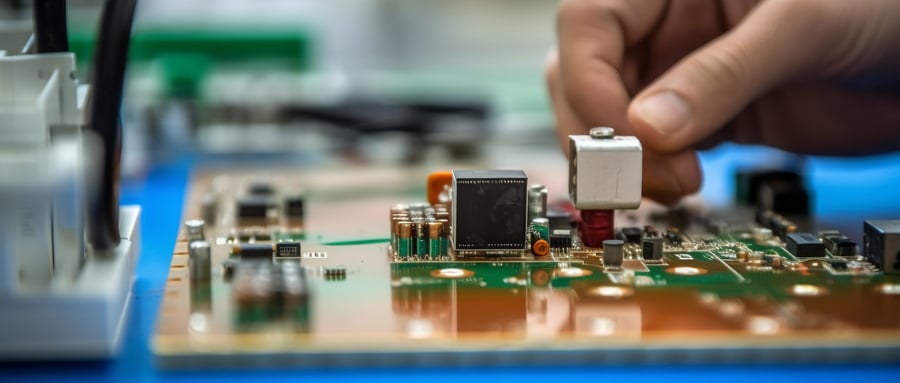A Comprehensive Guide to the Components of PCBs
Printed Circuit Boards (PCBs) form the backbone of modern electronic devices, providing support and connectivity for various electronic components. A PCB comprises several components which work together to ensure its smooth functioning and functionality; in this article we’ll look at these key elements that compose it and their importance.
1. Components of PCB: Substrate/Base Material
A PCB’s substrate or base material serves as its core foundation, supporting other components while also providing mechanical strength. Most PCBs use fiberglass-reinforced epoxy laminates (commonly known as FR-4), though other materials like ceramics, polyimide or metal may also be utilized depending on individual requirements.
2. Components of PCB: Conductive Traces/Copper Foil
Conductive traces are made of copper foil etched directly onto a substrate to create pathways for electrical current to travel between components on a PCB. Due to its excellent conductivity and affordability, copper foil is usually chosen as its most conductive option – its thickness determining maximum current-carrying capability of the PCB.
3. Components of PCB: Soldermask
Soldermask is a protective coating applied to the surface of PCBs to act as an insulating material and to avoid unintentional electrical connections between traces, protecting them against corrosion and environmental factors, while simultaneously being aesthetic aesthetically. Most often green, other colors may also be available depending on preference and need.
4. Components of PCB: Silkscreen
The silkscreen layer adds visual information to a PCB, such as component labels, reference designators, logos and other markings. Printed directly onto its surface using a contrasting color – usually white – the silkscreen helps simplify assembly, testing and troubleshooting processes.
5. Components of PCB: Pads
Pads are areas of copper on a PCB surface designed to facilitate component mounting and soldering. They serve as mounting points and help secure them in place while connecting components together – typically through-hole or surface-mount devices (SMDs).
6. Components of PCB: Components
PCBs include an assortment of electronic components that serve different functions. This may include resistors, capacitors, diodes, transistors, integrated circuits (ICs), connectors and many others that play integral parts in the overall functionality of a device. Each one plays its own part.
7. Components of PCB: Via
Vias are small holes drilled through a PCB to connect various layers and allow electrical signals to pass between layers, simplifying complex routing while decreasing its size and complexity. According to their accessibility, vias may be classified into through-hole or blind/buried vias.
8. Components of PCB: Plated Through Holes (PTH)
These holes serve to interconnect copper traces across different layers, and components. Their creation involves electroplating copper onto the walls of drilled holes for reliable electrical connection between layers and components.
9. Components of PCB: Mounting Holes
PCB mounting holes are strategically positioned holes designed to facilitate the mounting and installation process on larger systems or enclosures. These holes offer structural support while making for simple attachment and securement of the board.
10. Components of PCB: Edge Connectors
Edge connectors are metal contacts located along the edges of a PCB that provide electrical connectivity between it and external devices or connectors, such as expansion modules or external connectors. Edge connectors may be used for interfacing with other PCBs or connecting external devices as needed.

printed circuit boards (PCBs) consist of many components that work together to ensure proper operation of electronic devices. Recognizing their role and significance is integral in designing, manufacturing, and troubleshooting PCBs – from their substrate, conductive traces, soldermask or components themselves each play an essential part in creating robust circuitry that’s reliable and secure.
FAQ:
- What are the Components of a PCB?
The components of a PCB (Printed Circuit Board) can be divided into two categories: The physical features of the board itself, and the electronic components that are mounted to the board. - What Physical Features does a PCB Contain?
These include the substrate, copper layers, solder mask, silkscreen, and pads. The substrate, often made from FR4 material, provides mechanical support. Copper layers form the electronic pathways. The solder mask protects the copper traces and the silkscreen indicates part placements and information. - What are Active Components?
Active components are elements that are capable of amplifying or managing power within the circuit. These include transistors, diodes, integrated circuits, and optoelectronic components. - What are Passive Components?
Passive components don’t amplify power and rely on the power from the circuit itself. These include resistors, capacitors, inductors and transformers. - What are Discrete Components in a PCB?
Discrete components refer to the electronic elements that represent a single circuit function, such as resistors, capacitors, inductors, and diodes. - What are Integrated Circuits (ICs)?
Integrated circuits (ICs), also known as microchips, are compact arrangements of millions of transistors, capacitors, and resistors etched onto a single piece of semiconductor material. They perform a wide variety of functions, such as amplifying signals, generating clock signals, and memory storage. - What are the Connectors on a PCB?
Connectors are used to interface the PCB with other boards, external devices, or power sources. Common types of connectors are header connectors, USB connectors, terminal blocks, and edge connectors. - What is Solder?
Solder is a type of fusible metal alloy used to create a durable, conductive bond between components and the PCB. It helps in creating an electrical connection as well as providing mechanical adherence. - What are Surface-Mount Devices (SMDs)?
SMDs are electronic components that are soldered onto the surface of a PCB. This technology allows more components to be placed on both sides of the board, increasing its functionality and complexity. - What are Through-Hole Components?
Through-hole components are characterized by leads that are inserted into holes drilled through the PCB and soldered to pads on the opposite side. They are typically used in PCB applications that require robust and durable component connections.























